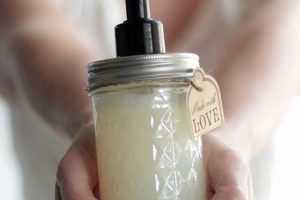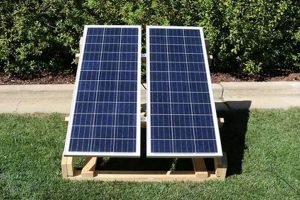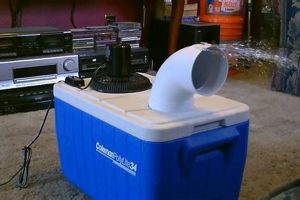Reusable fabric softeners, often crafted at home, represent an alternative to commercially produced, single-use products designed to reduce static cling and soften laundry in clothes dryers. These homemade versions typically involve soaking fabric squares in a solution of fabric softener, essential oils, or other natural ingredients. For example, a common recipe includes cutting up old t-shirts into squares and soaking them in a mixture of vinegar and essential oils before drying them for later use.
The significance of creating one’s own laundry aids stems from several factors. Environmentally, the reduction of single-use waste is a primary benefit. Economically, the cost savings over time can be considerable, especially with readily available household ingredients. Furthermore, individuals can control the ingredients used, avoiding potentially harsh chemicals or fragrances found in many commercial products, thus addressing sensitivities or allergies. Historically, the desire for more sustainable and personalized household solutions has driven interest in these types of alternatives.
The subsequent sections will delve into specific recipes and materials needed for crafting these homemade alternatives, detailing the steps involved in their creation, and exploring the advantages and disadvantages associated with their usage.
DIY Dryer Sheet Tips
Effective utilization of reusable fabric softening cloths requires consideration of several factors to maximize benefits and ensure optimal laundry results.
Tip 1: Fabric Selection: Opt for natural fibers such as cotton or bamboo. These materials absorb and retain the softening solution effectively, enhancing distribution throughout the drying cycle.
Tip 2: Solution Concentration: Begin with diluted solutions of vinegar or fabric softener. Over-saturation can lead to residue buildup on fabrics and inside the dryer.
Tip 3: Essential Oil Usage: Exercise caution when using essential oils. Certain oils can be flammable or interact negatively with synthetic fabrics. Always research compatibility before application. Lavender, lemon, or tea tree oil are generally considered safe and impart a pleasant, subtle fragrance.
Tip 4: Drying Temperature: Lower heat settings are recommended. High heat can degrade both the fabric and the softening solution, reducing effectiveness and potentially damaging the cloths.
Tip 5: Regular Refreshing: The softening solution depletes over time. Replenish the solution on the cloths after every two to three dryer loads to maintain optimal performance.
Tip 6: Storage Practices: Store the cloths in an airtight container when not in use. This prevents premature evaporation of the solution and keeps them fresh for longer.
Tip 7: Dryer Maintenance: Clean the dryer lint trap after each load, regardless of whether commercial or reusable cloths are used. This practice enhances dryer efficiency and reduces fire hazards.
Implementing these recommendations can significantly enhance the effectiveness and longevity of reusable fabric softening cloths, resulting in softer laundry, reduced static cling, and decreased environmental impact.
The following sections will address common questions and potential challenges associated with using homemade solutions, providing further insights into achieving successful laundry results.
1. Material Reusability
Material reusability stands as a core tenet within the realm of crafting homemade fabric softening cloths. This principle directly affects the sustainability and economic viability of creating alternatives to disposable dryer sheets.
- Source Material Longevity
The durability of the material used to create the cloths significantly influences their lifespan. Utilizing fabrics such as well-worn cotton t-shirts or microfiber towels, already present in the household, extends their useful life and reduces the demand for new textiles. Conversely, choosing less durable materials results in more frequent replacements, diminishing the environmental advantages.
- Washability and Maintenance
The capacity to launder and recondition the cloths after each use is paramount. Materials must withstand repeated washing without significant degradation to maintain effectiveness. Washing frequency and drying methods also impact material integrity, potentially necessitating adjustments to laundry routines. Some materials may require hand washing or air drying to prolong their usability.
- Solution Compatibility
The interaction between the cloth material and the softening solution determines the cloth’s efficacy and longevity. Materials must be compatible with common softening agents, such as vinegar or essential oils, without reacting adversely or losing structural integrity. Incompatible material-solution combinations can lead to premature degradation or reduced softening capabilities.
- Waste Reduction Impact
By employing reusable materials, the reliance on single-use dryer sheets is diminished, resulting in a tangible reduction in household waste. The extent of this reduction is directly proportional to the frequency with which the homemade cloths replace commercially available alternatives and the lifespan of the reusable materials. Extended material lifespan directly translates to a lower environmental footprint.
The selection of reusable materials for creating homemade fabric softening cloths is integral to their sustainability and effectiveness. Careful consideration of material durability, washability, solution compatibility, and waste reduction potential is crucial for maximizing the benefits of this alternative laundry practice. The use of diy dryer sheets is cost effective, reducing waste and harmful toxins that enter the air.
2. Solution Composition
Solution composition is a pivotal determinant in the effectiveness and overall performance of homemade alternatives to commercial fabric softening sheets. The specific ingredients and their ratios directly influence the ability of the cloths to reduce static cling, soften fabrics, and impart fragrance. For example, a solution primarily composed of white vinegar, while effective in softening and reducing static through its acidic properties, lacks fragrance. Consequently, the addition of essential oils becomes necessary to provide a desired scent. The type and concentration of essential oils, in turn, must be carefully considered to avoid staining fabrics or causing allergic reactions.
The selection of ingredients for the solution necessitates a careful balance between desired effects and potential drawbacks. Glycerin, for instance, can enhance fabric softening but may also leave a residue on clothing if used in excessive amounts. Similarly, fabric softeners designed for use in washing machin
es can be incorporated into the solution, but their concentration must be significantly reduced to prevent buildup and ensure compatibility with the reusable cloths. Experimentation with different solution compositions is often required to identify the optimal blend for specific laundry needs and preferences, especially when considering diy dryer sheets solutions that is used.
In summary, the choice and proportion of ingredients within the solution are crucial factors dictating the success of homemade fabric softening cloths. A thorough understanding of the properties and potential interactions of each component is essential for achieving the desired softening, static reduction, and fragrance without compromising fabric integrity or causing adverse reactions. This understanding can be applied to diy dryer sheets to make it effective in reducing static.
3. Scent Customization
Scent customization represents a significant advantage of crafting homemade alternatives to commercially scented dryer sheets. The ability to control the fragrance profile allows individuals to tailor the scent to their specific preferences, sensitivities, or allergies. Commercially available dryer sheets often contain synthetic fragrances that can trigger adverse reactions in sensitive individuals or conflict with preferred scents. Creating do-it-yourself dryer sheets permits the use of natural essential oils or fragrance oils, affording precise control over the type and intensity of the aroma infused into laundry. For example, someone with a sensitivity to lavender might opt for citrus-based essential oils to achieve a fresh, clean scent without experiencing allergic symptoms. The choice of carrier oil and its interaction with the chosen fragrance also influences the final olfactory outcome.
The process of scent customization involves several practical considerations. The type of fabric used for the diy dryer sheets influences the scent retention. Natural fibers tend to hold fragrances better than synthetic materials. The concentration of essential oils within the solution also plays a crucial role; higher concentrations result in a stronger scent, but may also lead to skin irritation in some cases. Furthermore, the drying temperature can affect the longevity of the scent; lower temperatures tend to preserve the fragrance more effectively. The choice of essential oils should align with the intended use of the laundry. Calming scents, such as chamomile or sandalwood, may be preferred for bedding, while energizing scents, such as peppermint or eucalyptus, may be suitable for workout clothes.
Effective scent customization in the context of self-made dryer sheets hinges on understanding individual preferences and potential sensitivities, carefully selecting appropriate fragrances and concentrations, and considering the impact of fabric type and drying conditions. While the process offers unparalleled control over scent profiles, it also necessitates diligent research and experimentation to achieve optimal results without compromising fabric integrity or triggering adverse reactions. The importance of diy dryer sheets lies in the user’s ability to use their own ingredients.
4. Cost Effectiveness
The economic viability of homemade dryer sheets hinges on a comparison of their production costs against the recurrent expenses associated with commercially available alternatives. The initial investment in materials such as fabric remnants, vinegar, and essential oils must be weighed against the ongoing purchase price of single-use dryer sheets. Cost savings materialize over time as the reusable nature of the homemade cloths eliminates the need for frequent repurchasing. For instance, a household that spends $10 per month on commercial dryer sheets could potentially reduce that expenditure to near zero after the initial investment in DIY supplies, provided the reusable cloths maintain their effectiveness over an extended period. Diy dryer sheets allows the user to buy the ingredients in bulk, thus saving money instead of going to the store all the time to purchase.
Several factors influence the overall cost effectiveness. The quality and durability of the fabric used for the cloths directly affect their lifespan, and therefore, the frequency with which replacements are needed. The price of essential oils can vary significantly depending on the type and brand, thus influencing the total cost of the softening solution. Utilizing readily available household ingredients, such as white vinegar, minimizes expenses compared to purchasing specialized fabric softeners. Proper maintenance, including regular washing and replenishment of the softening solution, is crucial for maximizing the lifespan of the homemade dryer sheets and realizing their full cost-saving potential. Diy dryer sheets costs are much less than commercial options.
In summary, the pursuit of homemade dryer sheets as a cost-effective alternative requires careful consideration of material selection, solution composition, and maintenance practices. While the initial setup may involve a modest investment, the long-term savings can be substantial, particularly for households that prioritize sustainable practices and seek to minimize recurring expenses associated with laundry. The actual savings will depend on frequency of laundry. Careful diy dryer sheets consideration is paramount for overall effectiveness.
5. Static Reduction
Static reduction constitutes a primary functional objective of both commercially manufactured and homemade dryer sheets. The accumulation of static electricity during the drying process results from the triboelectric effect, wherein electrons are transferred between dissimilar materials in contact and subsequently separated. Synthetic fabrics are particularly prone to this phenomenon. Dryer sheets, including DIY versions, aim to mitigate static cling by introducing lubricating substances that reduce friction and conductive agents that facilitate the dissipation of electrical charge. For example, vinegar, a common ingredient in homemade dryer sheet solutions, possesses mild conductive properties that aid in neutralizing static buildup. The effectiveness of static reduction is a critical factor in determining the overall success of any dryer sheet formulation.
The performance of homemade dryer sheets in reducing static hinges largely on the composition of the solution used. Solutions containing fabric softeners, even in diluted concentrations, deposit a thin layer of lubricant onto the fabric fibers, thereby minimizing friction and reducing the likelihood of electron transfer. Essential oils, while primarily added for fragrance, may also contribute to static reduction through their inherent lubricating properties. However, the efficacy of essential oils in this regard can vary significantly depending on their specific chemical composition. In practical terms, a well-formulated homemade dryer sheet should leave clothes feeling smooth and free from static cling, comparable to the results achieved with commercial products. Testing the sheets on loads containing static-prone fabrics, such as fleece or nylon, provides a reliable indication of their performance.
Achieving effective static reduction with DIY dryer sheets presents certain challenges. Over-saturation of the cl
oths with the softening solution can lead to residue buildup on clothing and inside the dryer, potentially negating the intended benefits. Inadequate solution concentration, conversely, may result in insufficient static control. Balancing these factors is crucial for optimizing the performance of homemade dryer sheets. The ability to successfully reduce static cling represents a significant value proposition for those seeking to create their own laundry aids. The practical significance of static reduction is the comfortable feeling. It also represents the knowledge of how and why static electricity reduction is a function of diy dryer sheets.
6. Fabric Softening
The function of fabric softening, when considered in the context of homemade dryer sheets, represents a key performance objective. DIY formulations are designed to replicate or improve upon the softening effects achieved by commercially available products, contributing to desirable tactile qualities in laundered textiles.
- Lubrication of Fibers
Fabric softening agents work by depositing a thin layer of lubricating compounds onto textile fibers. This lubrication reduces friction between the fibers, resulting in a smoother, softer feel. In DIY dryer sheet solutions, ingredients like vinegar or diluted commercial fabric softeners serve this purpose. The effectiveness of lubrication depends on the concentration of the softening agent and its ability to adhere to the fabric during the drying cycle. For example, an over-concentrated solution may lead to a waxy buildup, while an under-concentrated solution may provide insufficient softening.
- Neutralization of Static Charge
Static cling contributes to a rough, unpleasant texture in fabrics. Fabric softening agents often incorporate cationic surfactants, which neutralize the negative charges that cause static. In DIY formulations, the acidic properties of vinegar contribute to this neutralization. The extent of charge neutralization directly impacts the perceived softness of the fabric; reduced static results in a smoother, more pliable material. For instance, a load of synthetic fabrics treated with an effective DIY dryer sheet will exhibit significantly less static cling compared to an untreated load.
- Fiber Relaxation and Smoothing
The drying process can cause fabric fibers to become stiff and rigid. Fabric softening agents promote fiber relaxation, allowing the fibers to regain their natural flexibility. This relaxation contributes to a more supple and comfortable feel. DIY formulations incorporating ingredients like glycerin or essential oils can enhance fiber relaxation. The degree of fiber relaxation influences the drape and overall texture of the fabric; well-relaxed fibers result in a smoother, more flowing appearance. For instance, cotton towels treated with a fabric softening solution exhibit improved absorbency and a plusher texture.
- Enhancement of Drape and Appearance
Beyond tactile qualities, fabric softening also influences the visual appearance of textiles. By reducing wrinkles and enhancing drape, fabric softening agents contribute to a more polished and presentable finish. DIY dryer sheets, when properly formulated, can improve the overall aesthetic appeal of laundered items. The enhancement of drape and appearance is particularly noticeable in garments and linens, where a smooth, wrinkle-free finish is desirable. For instance, treated garments display enhanced drape and reduced wrinkling, resulting in a more professional appearance.
The achievement of effective fabric softening through DIY dryer sheets necessitates a careful consideration of ingredient selection, solution concentration, and application methods. By understanding the mechanisms through which softening agents interact with textile fibers, individuals can formulate homemade solutions that replicate or enhance the benefits of commercially available products, thus improving the tactile and visual qualities of laundered items. Diy dryer sheets can produce this effect.
7. Environmental Impact
The environmental impact of conventional dryer sheets is multifaceted, encompassing resource depletion, waste generation, and potential release of volatile organic compounds (VOCs). Manufacturing processes necessitate raw materials, including non-renewable petroleum-based components for the fabric softening agents and synthetic fragrances. The single-use nature of these products contributes significantly to landfill waste, as the sheets are typically non-biodegradable. Furthermore, the fragrances and chemicals released during the drying cycle can contribute to air pollution, both indoors and potentially outdoors, particularly through VOC emissions. The consideration of environmental impact is thus a critical component of evaluating the viability and merit of adopting DIY dryer sheet alternatives. For instance, the Great Pacific Garbage Patch stands as a stark reminder of the long-term consequences of single-use products, highlighting the importance of waste reduction in consumer choices.
DIY dryer sheets offer a potential pathway to mitigate these environmental burdens. Utilizing reusable fabric scraps, often repurposing textiles destined for disposal, reduces the demand for virgin materials and diverts waste from landfills. Formulating solutions with natural ingredients such as vinegar and essential oils minimizes the reliance on synthetic chemicals and fragrances, thereby reducing VOC emissions. The longevity of DIY dryer sheets, designed for repeated use, further diminishes waste generation compared to their single-use counterparts. Practical applications include composting used natural fiber cloths at the end of their lifespan, completing a closed-loop system. Moreover, individuals can choose essential oils with certified sustainable sourcing, further minimizing the environmental footprint. A real-world example is the growing trend of using refillable containers for household cleaning products, mirroring the principle of reuse inherent in DIY dryer sheets.
While DIY dryer sheets present a promising avenue for reducing environmental impact, certain challenges persist. The efficacy of different homemade formulations can vary, and improper use, such as over-saturation of the cloths, may lead to residue buildup in dryers. It is essential to research and test different recipes to ensure optimal performance and minimize potential drawbacks. The broader theme of sustainable consumption necessitates a comprehensive approach, encompassing not only laundry practices but also mindful choices across all aspects of daily life. The impact is undeniable, diy dryer sheets are better than store bought alternatives.
Frequently Asked Questions About DIY Dryer Sheets
The following questions address common concerns and misconceptions surrounding homemade alternatives to commercially manufactured dryer sheets. The answers provided aim to offer clarity and guidance for individuals considering the transition to DIY solutions.
Question 1: Will homemade dryer sheets damage the dryer?
When properly formulated and used, homemade dryer sheets should not damage the dryer. However, over-saturation with solution or the use of incompatible ingredients could potentially lead to residue buildup. Adherence to recommended recipes and regular dryer maintenance are crucial.
Question 2: How long do DIY dryer sh
eets last?
The lifespan of homemade dryer sheets depends on the durability of the fabric used and the frequency of use. With proper care, including regular washing and solution replenishment, they can typically last for several months, offering a cost-effective and sustainable alternative to disposable options.
Question 3: Can essential oils stain clothes?
Certain essential oils, particularly those with darker pigments, may potentially stain fabrics. Diluting essential oils in a carrier solution and testing on an inconspicuous area of fabric before widespread use is recommended to minimize this risk. Clear or lightly colored essential oils are generally preferable.
Question 4: Are DIY dryer sheets safe for all fabric types?
Homemade dryer sheets are generally safe for most fabric types. However, delicate fabrics may require a gentler formulation with reduced concentrations of softening agents. It is prudent to consult fabric care instructions and test on a small, hidden area before treating entire garments.
Question 5: How often should the softening solution be replenished?
The frequency of solution replenishment depends on usage. Inspecting the sheets after each drying cycle and replenishing the solution when the fabric feels dry to the touch is a practical approach. Typically, replenishment is needed after every two to three loads.
Question 6: Do DIY dryer sheets effectively reduce static cling?
When formulated with appropriate softening agents and conductive ingredients, DIY dryer sheets can effectively reduce static cling. The performance may vary depending on the specific recipe and the type of fabrics being dried. Adjusting the solution composition to suit individual needs is often necessary.
In summary, DIY dryer sheets offer a viable alternative to commercial products, provided that proper precautions are taken and formulations are carefully selected to align with individual needs and preferences. Attention to detail and a commitment to sustainability are key to realizing the full benefits of this approach.
The next section will explore advanced techniques and troubleshooting tips for maximizing the effectiveness of homemade dryer sheets and addressing common laundry challenges.
Conclusion
This exploration of DIY dryer sheets has detailed the multifaceted aspects of these homemade laundry aids, encompassing their creation, utilization, and impact. The analysis has addressed material selection, solution composition, scent customization, cost effectiveness, static reduction, fabric softening capabilities, and environmental consequences. Each element contributes to the overall viability and effectiveness of these alternatives to commercially produced dryer sheets.
The decision to adopt DIY dryer sheets reflects a broader commitment to sustainable practices and informed consumerism. Continued research and refinement of homemade formulations will likely yield further advancements in performance and environmental stewardship. Ultimately, the significance of DIY dryer sheets extends beyond mere laundry practices, representing a conscious effort to minimize environmental impact and promote responsible resource management.







